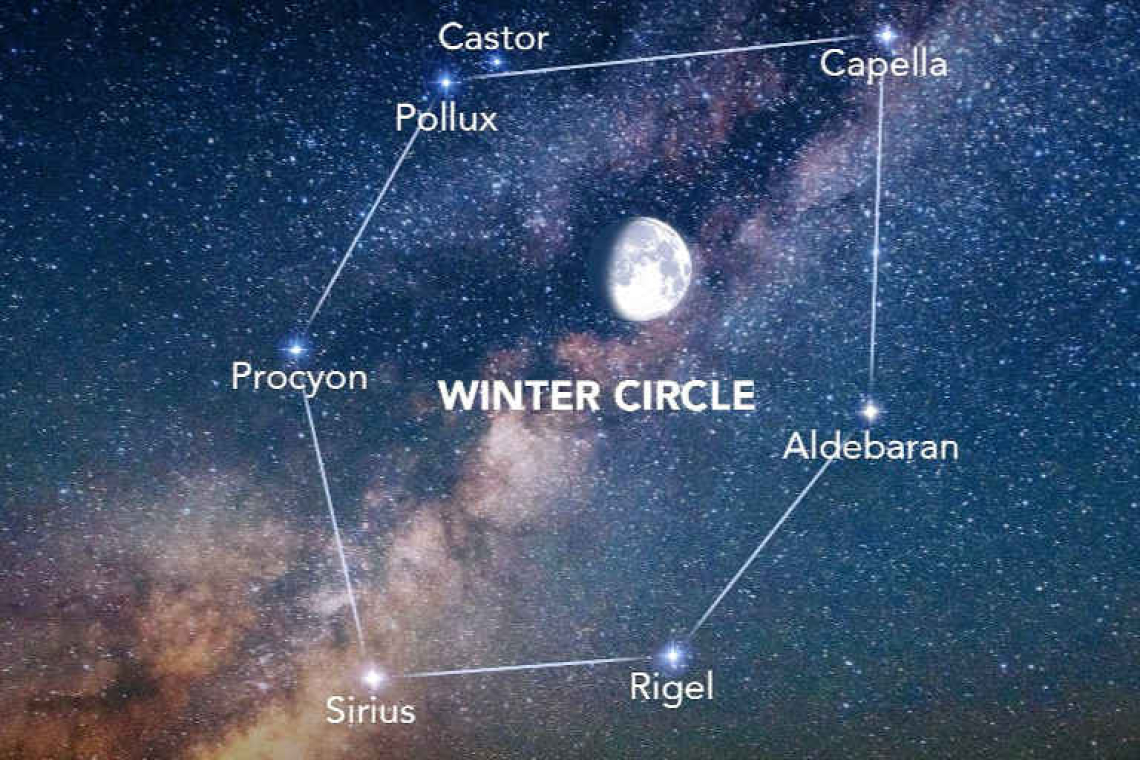Sun rises at 6:38am
Sun sets at 6:13pm
Lunar phase: 2nd quarter, waxing gibbous
Moon rises at 12:23pm
Moon sets at 1:09am
This weekend, look south just after sunset to find the half-moon hanging high in the sky, almost overhead. The half of the moon that is lit up will be pointing west towards the setting sun. The moon will drift westward through the evening hours until, about 1:00am, it sets leaving the sky dark and in the domain of the stars and planets.
Let’s revisit the evening hours, around 8:00pm – that’s a great time to get out and find some interesting celestial sights. The aforementioned half-moon will be within the Winter Circle on Saturday night. We love the Winter Circle here at the WEEKender, mostly because it’s an easy way to locate six constellations without straining the brain.
We start by finding Orion, his three stars in a row belt will be near the moon, and his shoulder is marked by the star Betelgeuse (pronounced beetle juice, yes, really). It’s worth noting that Betelgeuse marks the centre point of the Winter Circle and Orion’s foot, the bright star Rigel, is one of the seven bright stars that form the Circle. Let’s begin at Rigel and go around the Circle counter clockwise. From Rigel, look slightly left to find the brightest true star in the entire sky, Sirius, also known as the ‘Dog Star” because it sits in the constellation Canis Major or “Big Dog.”
To find Procyon, the Little Dog Star in the constellation Canis Minor, come around the circle and then continue until you find two similar stars bright and close together. These are the twin stars in the constellation Gemini. They go by the names of the mythological twins, Castor and Pollux. Continue on around the Circle and find Capella in the constellation Auriga, the goat herder. This star sits on the opposite side of the Circle from Rigel, and on Saturday night the moon will be between these two stars. Coming around the western side of the Circle, look for Taurus, the Bull, and the star that marks the Bull’s Eye is Aldebaran.
By the way, if you shoot straight out from Orion’s belt to Aldebaran and continue in a line a little less than that same distance, you will find the Pleiades star cluster, a tiny jewel box of very young stars, swaddled in swirl of dust and gas. Use your binoculars to see seven little stars in the shape of a tiny dipper. The Pleiades is sometimes called the Seven Sisters.
Not far from the Pleiades this weekend is the planet Jupiter. Keep those binoculars out for a chance to see the Solar System’s biggest planet and even a few of its larger moons. Enjoy the beauty of our starry, starry nights here on St. Maarten.
Thank you for keeping up with the Night Sky articles, backyard astronomy designed for St. Maarten sky viewing. FYI: If you are out later on in the week, note that each star rises about four minutes earlier each day than written here, and the moon rises 50 minutes later. Night Sky is researched and compiled by Lisa Davis-Burnett. Earthsky.org is a key resource for information and images. Questions or comments? Email This email address is being protected from spambots. You need JavaScript enabled to view it.







